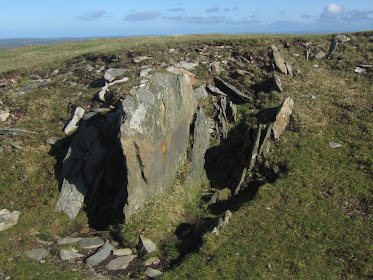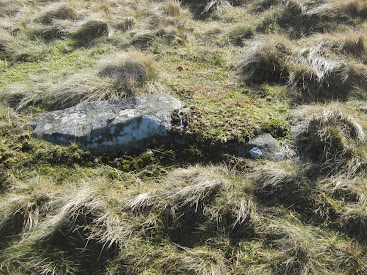The Durrington bluestone pebble, with a slice taken off it for analysis. The facets are very well weathered, and I do not think they are a result of human working......
Enough of Waun Mawn for the moment. I picked up on a comment on one of the discussion threads which mentioned a piece of bluestone found in a posthole numbered WA 95. Apparently, it was found between two radiocarbon dated layers and was therefore shown to have been in position around 7,000 yrs BC -- which places it solidly back in the Mesolithic. In other words, it was in position at a time when the archaeologists insist that there were no bluestones present on Salisbury Plain........... very inconvenient.
I have tried to track down the evidence, and have found a Wessex Archaeology Report on Durrington and Larkhill, which places posthole WA 95 near the Larkhill Medical Centre, at grid ref 412600 144900. There is a reference to 1999 WA research, and in one of the frelevent reports Matt Leivers of Wessex Archaeology is mentioned.
See also:
https://brian-mountainman.blogspot.com/2016/11/understanding-of-stonehenge-transformed.html
https://sketchfab.com/3d-models/durrington-bluestone-object-3457e4b573914410a63e05d0df7b1f30
This may or may not be the same bluestone pebble which I referred to in a past post:
https://brian-mountainman.blogspot.com/search?q=+Bluestone+pebble+Durrington
Front and back faces and profile view of the pebble. It is about 7 cm across, with 4 sides. Note the heavily abraded surface and the facets -- it I had picked this up near a glacier front, I would have found it to be a perfectly normal component of a glacial deposit........
When I first featured this pebble Rob Ixer told us that it was made of foliated rhyolite, similar to the rhyolite of the Pont Saeson / Rhosyfelin area. I'm not aware of any more accurate provenancing than that.........
In the descriptions, it is said to have come from the vicinity of two postholes -- but it is not recorded as having been actually embedded in either of those holes. It may of course have just turned up in the debris being thrown out of one of the pits. It's dated in the literature as either Neolithic or Romano-British, but I do not know whether that is simply "assumptive" dating -- based on the fallacious reasoning that the stone could not possibly have been in either of these pits earlier than "the arrival of the bluestones." In "Stonehenge for the Ancestors", Vol 1, p 177, there is a reference to a "discoidal tool of group C rhyolite from a Romano-British ditch". If that is the same pebble, it is a pretty strange way to describe it.......... There is a reference to a WA publication by Thompson and Powell in 2018.
I'd like to know more about this rather interesting pebble. Does anybody have more information from Wessex Archaeology, or elsewhere? Where is it now?
It's worth reminding ourselves that there are bluestone pebbles and fragments scattered all over the Stonehenge landscape. See this map, which has appeared in a number of publications:
Source -- Stonehenge for the Ancestors, Part 1, free digital download. It's very detailed, and does not reproduce well at a small scale.
Bearing in mind that this map shows only the bluestone fragments that have been found and recorded in placed where digging has gone on, we can safely assume that no part of the Stonehenge landscape is free of bluestone pebbles and / or fragments. On almost all occasions I can recall, the "fragments" (they are never referred to as pebbles or stones) are assumed to be in secondary positions, and assumed to be no older that Neolithic -- with no evidence cited. They are also assumed ALWAYS to be chips broken off Stonehenge bluestone monoliths that have been used for tool-making or otherwise destroyed. What I would like to know is "How do these bluestone bits and pieces relate to superficial deposits such as the clay-with-flints?"
There are lots of research projects needed on Salisbury Plain, and one of them is a systematic survey of the bluestone debris, with rigorous recording of field data and assumption-free interpretation. Until that work is complete, I think that when people say "There are no bluestones on Salisbury Plain, and therefore the glacial transport thesis is dead", I think I will reply "There are lots of bluestones on Salisbury Plain, and they look as if they might belong to a very old and degraded glacial deposit."
PS. More and more intriguing. There is a number on the base of the pebble, which looks like 74411 --5653 --36. Presumably the pebble is in the Wessex Archaeology collection.
This is the WA description:
The ‘bluestone’ object is a bifacial lithic with polishing and flaking. It was found in a possibly Romano-British feature, next to two Late Neolithic posthole alignments at MOD Durrington. It resembles objects made out of ‘bluestone’, the same as some of the Stonehenge stones. A number of ‘bluestone’ objects have been found across the Stonehenge Landscape, even though not local to the geology.
It is unknown when the object was created, or how it came to be buried at Durrington. Its proximity to the Neolithic posthole alignments could suggest a similar prehistoric date. However, the association with the Romano-British feature could suggest a later curation of the artefact, taken as a memento or trophy.
A section was taken to identify the geology of the rock and shows its original midnight blue colour when it was freshly made. The exterior surface is the result of 4500 years of weathering and wear.The presumption is that this is a man-made "object" -- and that seems to me to be a very strange characterisation, given its surface characteristics. Polishing and flaking? Artefact? A memento or trophy? Yet more interpretative inflation, based on the unsupportable assumption that the pebble could not have been here before the Neolithic. From a careful look at that nice 3D animation, this is a perfectly ordinary small glacial erratic.
-------------------
PS. Tim Daw has done a post on this pebble on his blog, and seems fairly certain this came from Durrington.. He has cited the following from WA:
"A discoidal 'bluestone' object with heavily ground and flattened edges was found in the tertiary fill of the northern terminal of Romano British ditch 6256 (slot 5145), 7 m from the intersection of the two Late Neolithic posthole alignments (at posthole 5047). The object, which has a rounded trapezoid shape, is 64 mm wide, 67 mm long and 18 mm thick. It is made from a slab of stone that has developed a light grey surface patina, although a fresh break in one corner suggests a poorly developed conchoidal fracture and is a dark grey colour when freshly worked.
Further, thin section petrography shows the artefact to be manufactured from rhyolite with a 'sub- jovian' texture, texturally one of the most extreme (and hence characteristic) of the Craig Rhosyfelin rhyolitic rocks. In hand specimen, this rock-type would be very distinctive.
Relict flake scars confirm that the blank was subjected to rudimentary bifacial flaking around the edges, although it is less certain by how much the sides of the object result from flaking or are products of natural fracture. The edges of the object are all heavily ground, with a distinct flattened facet around the circumference. This flattened facet is a sufficiently recurring feature of similar objects of the type to indicate that it was an original feature and not a subsequent alteration to the edge. Grinding also extended across both sides of the object by as much as 11 mm from the edges. The function of the object remains unknown.
"Elsewhere at Durrington in another Romao-British context there were found: "18 pottery disks clipped into roughly circular shapes. Suggestions for their use include spindlewhorl production, gaming counters or even ‘pessoi’ for cleaning after defecation."
That description is rather disappointing, with all those references to "an object" rather than a pebble, and an underpinning assumption that it is worked or fashioned either as a "pessoi" of for some other wholesome purpose. As I said above, I have seen thousands of similar pebbles close to glaciers, and I suppose I could have described them in a similar fashion if had been minded to. People seem unaware of how glaciers affect and "fashion" the stones that are transported and dumped by ice.........





































